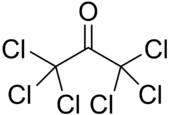Chemistry:Hexachloroacetone
From HandWiki

| |

| |
| Names | |
|---|---|
| Preferred IUPAC name
1,1,1,3,3,3-Hexachloropropan-2-one | |
| Other names
perchloroacetone
HCA | |
| Identifiers | |
3D model (JSmol)
|
|
| ChEBI | |
| ChEMBL | |
| ChemSpider | |
| EC Number |
|
| KEGG | |
PubChem CID
|
|
| RTECS number |
|
| UNII | |
| UN number | 2661 |
| |
| |
| Properties | |
| C3Cl6O | |
| Molar mass | 264.75 g/mol |
| Density | 1.7434 g/cm3[1] |
| Melting point | −2 °C (28 °F; 271 K) |
| Boiling point | 204 °C (399 °F; 477 K) |
Except where otherwise noted, data are given for materials in their standard state (at 25 °C [77 °F], 100 kPa). | |
| Infobox references | |
Tracking categories (test):
Hexachloroacetone is an organic compound with the formula (Cl3C)2CO. It is also called hexachloropropanone or perchloroacetone. Numbers indicating the position of the chlorine-atoms are generally omitted as all the possible positions are substituted with chlorine. It is a colorless liquid, slightly soluble in water.
Reactions and uses
Hexachloroacetone functions equivalently to trichloroacetyl chloride, i.e. as an trichloroacetylating agent.[2]
The main use of hexachloroacetone is as a pesticide. For the use of hexachloroacetone in the preparation of a novel insect repellent see Perkow reaction. The industrial route to hexafluoroacetone involves treatment of hexachloroacetone with HF:[3]
- (CCl3)2CO + 6 HF → (CF3)2CO + 6 HCl
See also
- Chloroacetone
- Dichloroacetone
References
- ↑ CRC Handbook of Chemistry and Physics, Internet Version, CRC Press (2005)
- ↑ Bernard Sukornick (1960). "α,α,α-Trichloroacetanilide". Organic Syntheses 40: 103. doi:10.15227/orgsyn.040.0103.
- ↑ Günter Siegemund; Werner Schwertfeger; Andrew Feiring; Bruce Smart; Fred Behr; Herward Vogel; Blaine McKusick (2002). Ullmann's Encyclopedia of Industrial Chemistry. Weinheim: Wiley-VCH. doi:10.1002/14356007.a11_349. ISBN 3-527-30673-0.
 |

